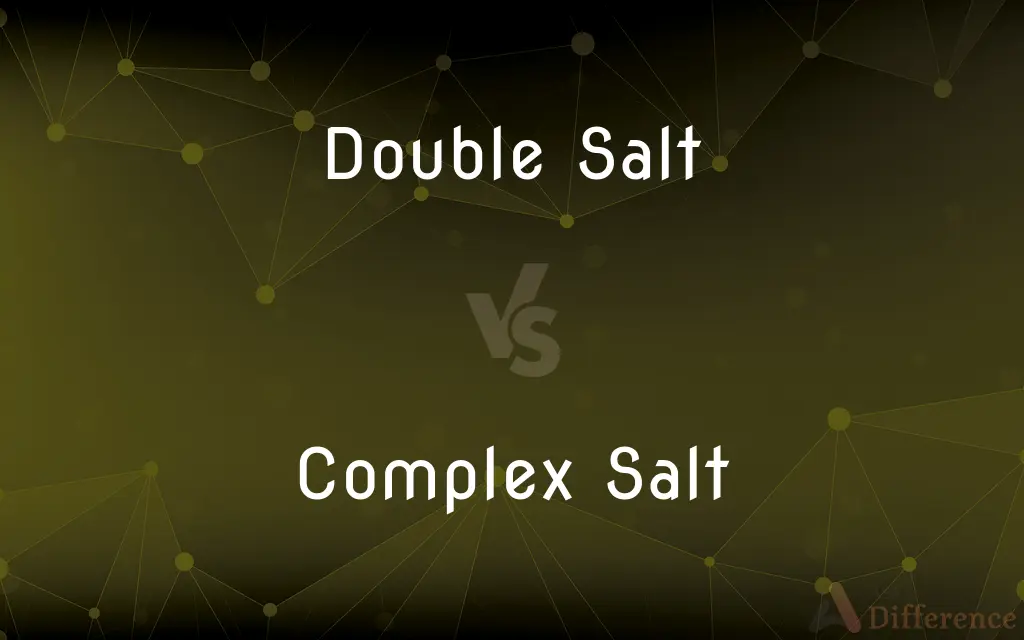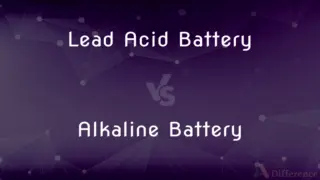Double Salt vs. Complex Salt — What's the Difference?
By Tayyaba Rehman — Published on November 13, 2023
Double salts contain two different cations or anions and dissociate completely in solution, whereas complex salts contain a complex ion and do not dissociate entirely in solution.

Difference Between Double Salt and Complex Salt
Table of Contents
ADVERTISEMENT
Key Differences
Embarking into the realm of double salts introduces us to compounds composed of two distinct salts, which, when dissolved in water, dissociate into their respective ions, forming a regular ionic solution. Exploring the entity of complex salts, we encounter salts containing complex ions, entities that when dissolved, do not dissociate completely into their constituent ions. Thus, double salts and complex salts, through their dissolution behavior, exhibit a fundamental difference in the resultant ionic presence within a solution.
Double salts, by nature, do not affect the pH of a solution as they break down into simple, non-hydrolyzing ions that do not interact with water molecules. On the contrary, complex salts, often forming due to the interaction of a metal ion with a lewis base, can influence the pH of a solution by producing ions that might undergo hydrolysis. This underlying characteristic sharply distinguishes double salts and complex salts in terms of pH modulation and interaction with aqueous environments.
Pertaining to their physical form, double salts, which typically form crystalline structures, encompass two distinct ionic salts that crystallize together but remain stoichiometrically independent. Divergently, complex salts, inherently incorporating coordination compounds, may display a range of colors due to d-d electronic transitions within their metal centers. Thus, double salts and complex salts, through their physical manifestation, elicit distinct structural and aesthetic differences.
Double salts, such as the well-known Mohr's salt, embody clear examples of entities where individual salts co-crystallize, maintaining their individual ionic identity upon dissolution. Whereas, complex salts, exemplified by [Cu(NH3)4]SO4, showcase a metallic ion centrally coordinated to typically organic ligands, where upon dissolution, the complex ion remains intact. Hence, double salts and complex salts, by virtue of their formation and resultant ionic behavior, highlight their distinctive identities and applications within the chemical domain.
From an application perspective, double salts, often utilized in electroplating, signify their practical importance in enhancing the depositing characteristics of metals on surfaces. Alternatively, complex salts find their prowess in colorimetric analysis, exploiting their colorful nature to gauge concentration and engage in qualitative analysis. In this, double salts and complex salts, through their respective practical applications, signify their indispensable roles in distinct chemical processes and analyses.
ADVERTISEMENT
Comparison Chart
Dissociation in Solution
Dissociates completely
Does not dissociate completely
Influence on pH
Does not affect pH
Can affect pH
Physical Appearance
Often colorless
Often colorful due to metal centers
Application
Used in electroplating
Used in colorimetric analysis
Compare with Definitions
Double Salt
Two Distinct Salts
Double salts, like alum, consist of two different salts crystalized together.
Complex Salt
Contains Complex Ions
Double Salt
Complete Dissociation
Complex Salt
Partial Dissociation
Double Salt
No Effect on pH
Complex Salt
Colorimetric Analysis
Complex salts, due to their colorful nature, find usage in colorimetric analytical methods.
Double Salt
Crystal Structure
Double salts form crystalline structures, evident in substances like Mohr's salt.
Complex Salt
Coordination Compound Inclusion
Complex salts contain coordination compounds, as seen in ferricyanide.
Double Salt
Electroplating Use
Double salts like copper sulfate and zinc sulfate are often employed in electroplating processes.
Common Curiosities
What are double salts?
Double salts are compounds of two different salts that dissociate completely into ions in solution.
Can double salts influence pH?
No, double salts dissociate into non-hydrolyzing ions and do not influence pH.
Why are some complex salts colorful?
Complex salts may be colorful due to d-d transitions in their metal ion centers.
Are double salts usually colorful?
No, double salts are often colorless as they don't contain transition metal complexes.
What is a common use of complex salts?
Complex salts are often used in colorimetric analysis due to their colorful nature.
What defines complex salts?
Complex salts contain complex ions and do not dissociate completely when dissolved in solution.
What happens to double salts in aqueous solutions?
Double salts dissociate completely into their constituent ions in aqueous solutions.
Do double salts maintain their ionic identity upon dissolution?
Yes, double salts dissociate completely, maintaining individual ionic identities.
Are double salts utilized in qualitative analysis?
Not frequently, as double salts typically do not have unique color properties useful in qualitative analysis.
Can complex salts be utilized in electroplating?
Generally, complex salts are not utilized in electroplating like double salts.
Do complex ions in complex salts remain intact in solution?
Yes, complex ions in complex salts remain intact when dissolved in solution.
Can complex salts form crystals?
Yes, complex salts can form crystalline structures with vibrant colors.
Are double salts employed in colorimetry?
Double salts are not commonly used in colorimetry due to often being colorless.
Share Your Discovery

Previous Comparison
C1500 Chevy Trucks vs. K1500 Chevy Trucks
Next Comparison
Lead Acid Battery vs. Alkaline BatteryAuthor Spotlight
Written by
Tayyaba RehmanTayyaba Rehman is a distinguished writer, currently serving as a primary contributor to askdifference.com. As a researcher in semantics and etymology, Tayyaba's passion for the complexity of languages and their distinctions has found a perfect home on the platform. Tayyaba delves into the intricacies of language, distinguishing between commonly confused words and phrases, thereby providing clarity for readers worldwide.












































